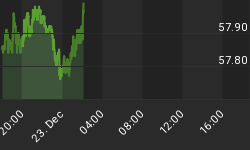Yes, according to Dow theory, the Secondary trend remains positive. My intermediate-term Cycle Turn Indicator had turned down at the March high, but then turned back up in association with the April low. So, as of this writing, things are once again positive for the market from a price perspective. However, the internals continue to lag with the latest cycle advance being the weakest since the advance out of the 2002 low began.
One of the things we have been watching over the last couple of months is the weakening internals and when I say weakest, I mean internally. With the market now once again at its recovery high and in position to challenge the all time high, it's a good time to review the internals in order to update you on their continued lack of confirmation.
The indicator in the upper window of the chart below represents the net difference between advancing issues and declining issues and is constructed in a manner so that it is reflective of the of the 22-week cycle. This indicator is constructed differently than some of the ones I've shared with you in the past, but the results are nonetheless the same. Note that this indicator peaked with the June 2003 22-week cycle top and has created a series of progressively lower peaks since. These progressively lower peaks are representative of the progressively weakening breadth.

In the next chart below I have another breadth indicator. This one simply divides advancing issues by declining issues, but again is tied or timed to the 22-week cycle. You can see here that the June 2003 22-week cycle top occurred with advancing issues over 1.6 times that of the decliners. History shows that most every important advance has begun with an initial burst by this indicator to a similar level or higher. But, now the problem is that history also shows us that weakening breadth with such divergences, as are now in place, are typical as the market moves into important tops. The fact that the market just made a new recovery high with this indicator showing advancing issues at a mere 1.21 times declining issues is another indication that an important top is likely approaching. Let me explain.

As the market begins its initial run up out of the 4-year cycle low, breadth expands and this ratio will rise. Then, as the market progresses up into the 4-year cycle high breadth begins to contract as the market thins. At the 2000 4-year cycle top this indicator peaked with the final price high at 1.0. At the 1998 4-year cycle top this indicator peaked at 1.08. The following are the readings of this indicator at other recent 4-year cycle tops. In 1994 it was 1.19. 1990 was 1.25. 1987 was 1.27. 1981 was 1.26. 1976 was 1.19. 1973 was 1.28. 1968 was 1.2 and 1966 was 1.11. The most recent price high was made with this indicator sitting at 1.21. So, the point here is that we have the divergences and the readings on this final leg up now in the zone in which every 4-year cycle top over the last 30 years has occurred. Sure, price can still move higher and breadth can still contract even more, which would yield an even lower reading. But, we have been monitoring weakening internals and now the reading that we are seeing here is indicative of the 4-year cycle top that just happens to be coming due.
Below I have plotted a chart of the Industrials along with an little different intermediate term advancing issues line in green and the corresponding declining issues line in red. This charts gives us a little different look at the same data on the first two charts above.

There are a couple of things to note here. One, each of the advancing issues lines associated with each of these intermediate term cycles has also occurred at a lower level than the previous one. Two, as the market moved up into each of these intermediate term cycle tops, the advancing issues began to diverge with price. This non-confirmation occurs as a result of a thinning market, which is a naturally occurring phenomenon at cycle tops. Advancing issues, now only marginally above declining issues, as price has made a new recovery high is simply not healthy. Sure, price is positive and I'm not here to argue the obvious. But what I am telling you is that the health of the advance is poor and bulls should be dancing close to the door. The internals tell us that there is a change coming.
In addition to the fading breadth data, we continue to also have important non-confirmations that continue to linger. One such non-confirmation is between the Industrials and the Dow Jones Top Ten Index. For those not familiar with this index it represents the top ten dividend yielding stocks within the Industrials. The fact that these non-confirmations continue to exist is troubling for the market as the last such non-confirmation occurred surrounding the 2000 top 4-year cycle top.
Understand that these non-confirmations and weak internals are not signals, but are rather signs of the times. They are indications of changes that are in the making. If you would like more information surrounding my 2006 outlook, the set up and specific expectations for the remainder or this 4-year cycle, my intermediate-term Cycle Turn Indicator that is used to identified every major turn point and more, then visit www.cyclesman.com for subscription information.
















